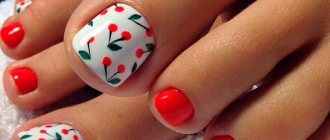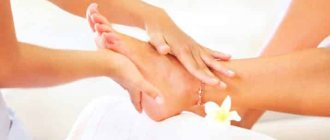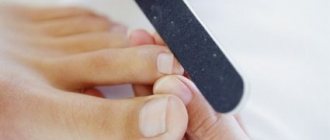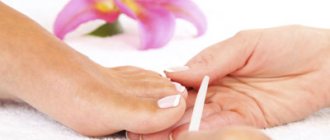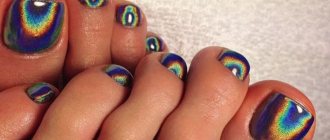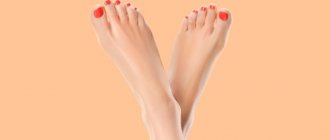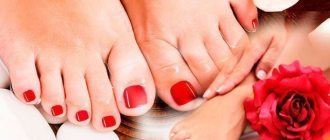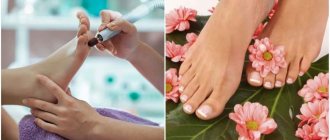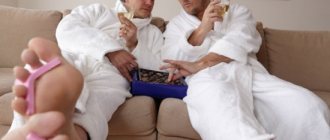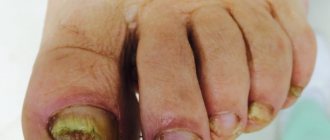From this article you will learn:
- What is medical pedicure
- How does a medical pedicure differ from a regular procedure?
- What are the indications and contraindications for medical pedicure?
- In what cases is it definitely worth getting a medical pedicure?
- What are the features of a medical pedicure for fungus and ingrown toenails?
- How to do a medical pedicure
- Where to get a medical pedicure
- How much does a medical pedicure cost?
- Is it possible to do a medical pedicure at home?
In the summer, you won’t be able to show off in open shoes if you have unkempt feet with calluses and cracked heels. They urgently need to be brought into proper shape, but this is not always possible to do on your own at home. Unprofessional treatment can even cause fungus to appear on the nails. In this case, you need to trust a specialist and undergo a medical pedicure, which allows you to almost completely remove fungal disease and other pathological changes in the nails.
What is medical pedicure
Medical pedicure has deservedly gained popularity. It is this method of treating feet that is used by famous artists, singers and other stars. This type of nail correction eliminates many painful pathologies on the legs. Methods of performing medical pedicure are studied by podology - this is a science at the intersection of surgery and dermatology. You should seek professional medical help to deal with the problem of ingrown toenails, fungus, or excessive sweating of the feet.
This procedure is distinguished by the fact that it can only be performed by a doctor who has been trained in medical pedicure. During the session, the specialist does not use water baths; lotions and special creams are used to soften the stratum corneum of the skin. A podiatrist performs a medical pedicure using a device with several types of attachments, which allows, without causing pain, to clean the keratinized top layer of skin, remove corns, and treat the cuticle. The master does not use sharp metal files or other devices.
Medical pedicure and manicure are significantly more expensive than hygiene care, and such services cannot always be obtained in a regular salon. If you need just such a procedure, be sure to first check whether the specialist has a specialized education.
A podiatrist doesn’t just perform aesthetic tasks to make your legs well-groomed and beautiful, he also provides treatment.
Read material on the topic: Combined pedicure: advantages and disadvantages
Who needs a medical pedicure?
Nail fungus or onychomycosis is an insidious enemy. Wherever he watches over his victims! In pools and bathhouses, on the tables of massage parlors and in the beach sand, on other people's slippers at a party... you can't list it all. Not a single person is 100% protected from encountering this dirty trick. Even worse, we ourselves pave the way for infection into our body when we poorly comply with hygiene requirements. Or we wear synthetic socks along with tight shoes. Or we undermine the immune system with an incorrect lifestyle. In a word, it is not surprising that statistics show that every fifth inhabitant of the planet has a fungus.
By the way, would you like to take a test for the presence of an uninvited guest on your nails right now? If you have:
- there was itching on the skin of the feet;
- the lateral rollers of the toes periodically turn red, swell and swell;
- the nail plates turned yellow, became noticeably thicker or became loose, and voids formed under them -
- this is a good reason to see a specialist. And if your nails begin to crumble and pus sometimes appears from under them, you need to make an appointment immediately.
Usually the fungus is an unpleasant sight
A podiatrist (this is the name given to doctors who deal with foot diseases) will examine you, take the necessary tests and prescribe treatment, part of which may well be a medical pedicure.
How is it different from cosmetic? The task of a regular pedicure is to give the nails an aesthetically attractive appearance, while the therapeutic procedure is aimed at removing the areas of the nail affected by the fungus and eliminating the very cause of the disease. However, you don’t have to worry about appearance either; After visiting a podiatrist, your legs will look well-groomed and beautiful. It is not without reason that many resort to pedicure , even without suffering from fungus, for the purpose of prevention.
You should only trust the procedure to a doctor or a beauty salon worker with a special medical education. This is the only way you can be sure that you will receive a quality service, and not a cheap imitation.
How does a medical pedicure differ from a regular procedure?
Medical hardware pedicure is a unique therapeutic and preventive procedure, only externally resembling a standard session of hardware hygienic treatment of feet.
Let's highlight the main features:
- A medical pedicurist uses a device that has a set of different cutters with an abrasive surface, and with its help removes keratinized areas and corns without causing harm to healthy skin.
- Using large attachments, you can carefully remove the upper hard layer of the epidermis, treat cracks on the feet and thickenings on the nail plates.
- Small diameter abrasive attachments are suitable for bloodless treatment of ingrown toenails. Sometimes the complexity of this procedure corresponds to a surgical operation.
- When performing a medical pedicure, unlike a trim pedicure, there is no risk of injuring the skin or cutting the cuticle. This is especially important for older people with diabetes. Even a small wound can lead to the development of dangerous diabetic foot syndrome. Therefore, only foot care from a medical pedicurist is suitable for them.
- The device can cope with the removal of the roots of warts, papillomas and calluses.
- Only a specialist podiatrist can be trusted to treat nail fungus.
- Blood circulation in the legs improves, the skin looks healthy and clean.
Read material on the topic: Types of pedicure: examples of the most popular today
Features and benefits of medical pedicure
Medical pedicure has a number of features:
- the work uses a special device with nozzles, cutters and caps of a certain direction;
- the treatment is carried out on a dry foot without preliminary steaming;
- all actions are carried out only by a specialized doctor;
- attachments remove the stratum corneum of the skin, leaving the living epidermis unaffected;
- the procedure improves blood circulation, the skin becomes smooth and velvety;
This type of care allows you to cope with the most common foot pathologies: fungus, cracks, calluses. Medical treatment of the feet differs favorably from other methods in that it:
- cures the disease rather than masks the symptoms;
- safe and bloodless;
- eliminates the risk of contracting infectious diseases through the use of disposable nozzles and constant disinfection;
- painless for most patients (with the exception of people with sensitive skin);
- allows you to get rid of foot diseases without cuts and operations.
Medical pedicure is the only foot care option allowed for patients with diabetes and pregnant women.
Indications and contraindications for medical pedicure
It is necessary to undergo a medical pedicure procedure at the clinic if:
- the skin on the feet is dry, flaky, itching and redness have appeared;
- nails change structure, shape, color.
Medical hardware pedicure copes with the following problems:
- corns;
- brittle, weak, thin nails;
- warts on the foot;
- ingrown nail;
- hyperhidrosis;
- tired legs;
- phlebeurysm;
- “cold” foot;
- injured nails;
- heel spur;
- diabetic foot.
It is also good to do a medical pedicure as a preventive measure. There are several contraindications that should not be ignored.
You cannot do the procedure if:
- You have very sensitive skin;
- Diagnosed with liver and kidney diseases;
- There is a predisposition to allergies and intolerance to the chemical components used during the session.
During a pedicure, a specialist uses various drugs, so pregnant and breastfeeding women should also refrain from the session in order to avoid exposure to chemicals that penetrate the skin into the body of the mother and child. For example, antifungal nail polish contains many toxic components. And it may turn out that we treat one thing, and cripple the other. It is better to perform only cleaning and wellness procedures.
Read the material on the topic: Pedicure set: equipment, rules of use, recommendations for selection
Features for various pathologies
Diabetic foot syndrome
In diabetes mellitus, there is a deterioration in the blood supply to the lower extremities, and their sensitivity also decreases. It is these two reasons that lead to the fact that the skin on the feet becomes thin, dry, and the nails become brittle, thick and shapeless.
Unfortunately, diabetes mellitus is a contraindication for a classic pedicure, but a medical hardware pedicure is considered a salvation for such patients. You need to work with such clients carefully and carefully, as they have reduced sensitivity in their limbs. Because of this, complications are sometimes possible - small burns: cutters and other attachments heat up during the procedure due to the high speed of rotation and friction.
You also need to carefully monitor the tightness of the instrument’s contact with the skin to avoid accidental injuries. To work with patients diagnosed with diabetic foot syndrome, it is necessary to use fine abrasive diamond tips.
We recommend reading the article about whether to remove or leave a mole.
Ingrown nail
A medical pedicure for an ingrown toenail is your choice if you have a strong fear of hospitals and there is no suppuration in the problem area yet. Podologists treat this pathology using the following methods:
- Overlay of gold plate. This technique is good if the nail plate is thin and the side fold is painful and sensitive. The goldspang is made from surgical steel and plated with gold, its width is 3 mm, thickness is 1 mm.
- Using the Podofix plate. This is a strip of elastic plastic that is glued to the nail with a special glue, and later attached to the nail with a metal wire. This method is acceptable in the presence of hypergranulations (overgrowth of adjacent tissues), curled nails, and treatment of calluses with a core in the area of the nail fold.
- Onyclip plate: a metal plate coated with epoxy is glued to the nail. Used for increased sensitivity of the roller (side).
- Using a duroplastic, fiberglass-coated plate. It attaches to the nail and, thanks to its springy properties, lifts the edges of the nail above the side ridges.
- COMBIped method – for inflammation of the nail folds, curling of the nail, unilateral ingrowth of the nail plate. A metal bracket is used with one curved end (it goes under the nail plate), its other end is a plastic platform that is fixed to the nail from above. In this way, you can correct only one edge of the nail.
Watch a video about correcting an ingrown toenail during a medical pedicure:
Fungal infection of the foot
Medical pedicure for foot or nail fungus should be carried out in conditions that are as close as possible to a sterile operating room. This is necessary to prevent infection of healthy tissues. In the process of medical pedicure, products containing high concentrations of antifungal drugs are used.
After a pedicure, all disposable attachments are disposed of, and stationary equipment is disinfected.
With the help of hardware pedicure, it is possible to painlessly remove affected nail plates and preventive treatment of intact (uninfected) nails.
Watch a video about medical pedicure for foot fungus:
Hyperkeratosis, calluses, corns
If you have hyperkeratosis of the feet, do not despair - just treat the skin with ceramic attachments several times, and it will again become smooth, even, pleasant to look and feel.
Shallow core calluses can also be removed using this manipulation. After local anesthesia and disinfection, the doctor uses cutters of various sizes to drill out the callus from the root. An antiviral drug is instilled into the resulting hole and an aseptic bandage is applied. To completely get rid of calluses, you need to complete a course of 3-6 sessions of medical pedicure.
Corns are a local thickening of the stratum corneum of the epidermis caused by uncomfortable shoes or prolonged and frequent walking.
This inconvenience can be eliminated by using softening agents and regular grinding.
Watch a video about medical callus removal:
Medical pedicure for nail fungus
Nail fungus or “onycholysis” is difficult to treat. Without proper attention to this problem, the process may become irreversible. But you can still restore a healthy and beautiful appearance to your nails. If you contact us in a timely manner, the doctor will perform a medical pedicure.
What does it include:
- painless and gentle removal of a nail area deformed by fungus;
- cleaning and preparing nail plates and skin for treatment with medications;
- procedures to enhance the effects of medications used;
- comprehensive care, operations and monitoring;
- implementation of preventive measures during the treatment procedure.
A qualified doctor and special equipment allow you to get a medical pedicure for nail fungus. The upper overgrown layer is cut off with a cutter; this stage prepares the surface of the nail plate for the effects of medications. Gradually, medicinal ointments penetrate to the source of the lesion, and the growth of the fungus stops.
Healthy nails are cleaned and polished to completely prevent the development of “onycholysis.” Medical pedicure sessions with a podiatrist should be carried out regularly until complete recovery.
Recommended articles on this topic:
- Where to buy nail files
- How to choose a manicure set for a beginner master
- Pedicure files wholesale
You have come to the salon. What's next?
If this is your first time doing this procedure, then you are, of course, interested in knowing what awaits you. And only pleasant sensations and positive emotions await you! Here's how a classic pedicure works:
- The master makes a bath especially for your feet with the addition of liquid soap, various cleansers and softening agents. This allows you to effectively disinfect your feet, remove possible contamination and soften the skin for further manipulation.
- Using a special nail file, the master removes dead skin on the heels, along the foot, and near the toes.
- Nails are being tidied up. The edge of the plate is filed and the cuticle is processed. After this, the cuticle and ridges around the nail are lubricated with nourishing oil or emulsion.
- The final treatment of the feet is carried out, the remaining dead skin is removed, and the feet are polished.
- The feet are wiped with a napkin to remove excess moisture. Then the master gives a light massage with a nourishing or moisturizing cream.
The big advantage of this procedure is sterility. The bath is done separately for each client, and the procedure itself is carried out only on soft skin, which can be easily removed without damaging the surface of the foot. In professional salons, such a hygienic pedicure is carried out under a special lamp, which allows you to see all the shortcomings in the master’s work and quickly remove them. The technician must wear gloves from the beginning of the procedure to its completion.
Medical pedicure for ingrown toenails
A medical pedicure will help in the initial stages of onychocryptosis. Several methods have been developed to eliminate ingrown toenails:
- The gold plate is made from surgical steel coated with gold. During the session, it is glued to the surface of the nail to adjust its shape. A gold plate is recommended for use if the patient has a thin nail structure and high sensitivity of the lateral ridge.
- The Podofix plate is a thin plastic strip that is fixed to the nail plate with special glue. After some time, they are strengthened with metal wire. The method is used for high intensity tissue growth.
- Duroplastic plate is a strip with special springing properties, containing fiberglass. It is attached to the edges of the nail plate to correct the growth of the nail and lift it above the skin ridges.
- COMBIped is a method in which a thin metal bracket is placed under the nail, and the other end is secured with a plastic end. This technology is used for purulent inflammation of the lateral ridge and unilateral ingrown nails.
Read material on the topic: Professional pedicure files: 3 main selection criteria
Medical hardware pedicure. What does the procedure consist of?
27.12.2016
| no comments
What is the difference between medical and aesthetic pedicure? The word “medical” should not confuse you, creating the false impression that podiatry is practiced by doctors. Podology is a paramedical specialty, it is not dealt with by doctors, but by foot specialists who have both medical knowledge and practical skills.
Unlike podiatrists, doctors have much more extensive knowledge, but not always sufficient practical skills and manual dexterity.
Podology is a specialty that is only associated with medical practice. A specialist called a podiatrist is not a de facto doctor, but he has sufficient professional knowledge about the health of human feet. Consequently, it also has a good practical basis.
The main difference between podiatry and aesthetic foot care is the end goals. Why do we visit a pedicure salon? First of all, to “bring beauty” - to make the legs aesthetically attractive. The master can shorten the nails, correct their shape, remove excess skin and apply a beautiful varnish. In most cases, this cosmetics only masks defects, but does not cure them. So, often gel is applied to a sore nail and thereby hides the problem. A medical pedicure is done to find a defect or disease and eliminate it.
The purpose of a medical pedicure is to recognize foot problems, eliminate their symptoms and, if possible, their causes. Such work not only does not always improve, but can also temporarily ruin the appearance of the foot (for example, wearing a brace, cleaning a fungal nail, wearing an orthosis, an occlusive bandage, etc.)
Eliminating problems as part of a medical pedicure often leads to a visual improvement in the appearance of the foot, one might say, to its decoration. But in podiatry this is not the main task, but rather a pleasant side effect. Typically, the work of a podiatrist is aimed at restoring the functions and health of the foot, and appearance is only added to them. Ideally, the result of the podiatrist’s work is the return of the foot to its natural state.
In conditions of possible discomfort experienced by the client, podiatrists work quickly and accurately, using special installations, as well as hygienic instruments. He also has things on hand that a regular salon won’t help you with: blanks for prosthetics, bandages, antiseptic ointments and painkillers. You may not achieve beauty right away: after the procedure, some people have to walk for a couple of weeks with a bandage, brace or foot support. But over time, you will get healthy feet that don't need masking. A podiatrist works to restore our body to the appearance intended by nature - and this naturalness is beautiful!
Cooperation between doctors and podiatrists
A podiatrist is not a doctor. It is an extension of the doctor's hand. The science of podology is closely intertwined with medicine, and in his practice, a podologist necessarily consults with other specialists in the matter: a surgeon, an orthopedist, a dermatologist, etc. Anyone can get an appointment with a podiatrist, not necessarily people with advanced illnesses. It happens that the nail grows even in infants, and school-age children catch foot fungus due to unsanitary conditions at school. Whatever your profession, income, or position in society, you can always come for a consultation and learn more about the health of your feet. You will learn the secrets of caring for them: how to choose shoes, what loads are good for your feet, what exercises help with pain and cramps, and similar facts.
What does the procedure consist of?
The service of medical hardware pedicure cannot be cheap, because... initially requires quite a large investment in its implementation - from the expensive training of a specialist and the purchase of specialized equipment, and ending with the fact that the specialist works with complex foot problems, incl. fungal diseases. Therefore, it is necessary to be confident that this service is provided in full and in compliance with all standards. What should it include? The hardware pedicure procedure is performed on a professional pedicure machine with a power of 30,000 or more revolutions per minute. The treatment of the foot and nails is carried out with special cutters, which differ in many parameters, for example, in shape, size, abrasiveness, and the material from which they are made. And they are selected by the master depending on their purpose. The master also uses hand tools - scrapers, nippers, cutters, files, etc. All this is carefully processed in accordance with SES standards and stored in a special UV lamp designed to maintain the sterility of the instrument. Before starting work, metal and other instruments that are not afraid of high temperatures are “fired” in a Glasperlene sterilizer directly in the presence of the client.
Before starting the procedure, the master can give the client a hygienic softening bath, and then apply an alcohol- or water-based skin antiseptic, or immediately treat the feet with an antiseptic if he intends to do the procedure “dry” - this depends on the condition and sensitivity of the skin of the feet. Of course, the master's hands and gloves are treated. If the nail plates are very thick, their thickness is removed to normal (1 mm), the optimal anatomical shape for the patient is given, and they are also ground and (if necessary) polished. If the nails become ingrown, the master removes the ingrown parts of the nails. The hardware treatment includes the removal of all keratinized areas of skin between the toes, on the knuckles and on the soles, grinding the skin, removing calluses and treating cracks, if any. At the end of the procedure, the master re-treats the feet with an antiseptic. The procedure includes the use of professional medicinal cosmetics for nails (oil or cream), application of cream according to skin type and light foot massage.
In some cases, the client does not need to undergo a full medical pedicure, then it is possible to work only on a specific problem. For example, if you only need to file down nails affected by fungus, remove calluses, or treat painful cracks in the heels.
The cost of the procedure depends on the complexity, volume and time required and is negotiated before the service begins.
Walk through life easily and without pain! With wishes of health, Your Foot Doctor, Master Podiatrist Natalya Gorbacheva
Kostroma, st. Galichskaya, 29, office 7 Tel.,
Latest Posts
How to do a medical pedicure
A pedicure at a medical center lasts an hour and a half and is performed in several stages:
- Treatment of feet with preparations with disinfectant properties.
- Softening the skin of the feet with special means so that keratinized areas and calluses are easier to treat. The drugs used have kerastolic properties. They make only rough areas of dead skin softer and more elastic, while healthy skin does not suffer.
- A medical pedicurist uses a device equipped with various attachments to clean the softened upper layers of skin. The cutters are changed to clean the most inaccessible places.
- Apply nourishing foot oil and cuticle cream for a certain period of time. The skin of the feet is softened, nourished and rejuvenated.
- Therapeutic procedure with cream against dryness, increased sweating and fungal infections.
- Special massage of the legs to the knees to increase blood circulation.
- A base coat for nails with microelements and calcium that strengthens the nail plate.
- Decoration with decorative varnish if desired.
Before the pedicure session, the specialist thoroughly cleans the patient’s chair and his workplace with disinfectants. The master works in a robe, mask, closed shoes and latex gloves.
Read the material on the topic: Disinfection of manicure instruments is an important stage in the work of a master
Is it possible to do a medical pedicure at home?
Medical pedicures are performed by long-term doctors in equipped premises. For those who cannot leave home (people with disabilities, people with diabetes), an on-site pedicure service is provided. It adds to the total cost from 1000 to 2500 rubles.
Without experience, it is not advisable to begin medical treatment of feet at home: you can damage the skin, not clean the nail plate well enough, or cause an infection. Those who decide to undergo an independent procedure need to remember that it will be different from the salon procedure.
Home medical pedicure is performed in several stages:
- preparing a towel, cotton pads, a basin with warm water (pre-soak the gel or soap in it), the necessary tools - scissors, tongs, a file, an orange stick, etc.;
- steaming legs;
- removal of the keratinized layer of skin with pumice stones and forceps;
- processing cuticles with a wooden stick;
- trimming the nail, giving it shape using a file;
- for ingrown toenails, calluses, fungus - no independent action, just consult a doctor;
- for minor cracks - additional treatment of the affected areas with pumice, then application of a healing cream;
- polishing uneven nails;
- coating application.
This pedicure is performed for preventive purposes and bears little resemblance to a high-quality medical procedure. If you have diseases of the feet and nails, you cannot self-medicate; only a sterile office and the experienced hands of a podiatrist will relieve you of the disease.
Where to get a medical pedicure
Modern beauty salons strive to include as many services as possible in their range. The very name of the procedure “medical pedicure” says where it can be done in compliance with all hygienic standards. Of course, in a medical center, then the effect will be maximum.
Let us list the main reasons why the choice should not be made in favor of a regular beauty salon:
- It is possible that you may become infected with a viral infection; it is possible that you were served by a person with such serious diseases as HIV, hepatitis B or C. Sometimes in salons there is a disdainful attitude towards sterilization of instruments, not to mention the workplace. In pursuit of profit, masters forget that the client may become infected during a pedicure session. And medical centers are equipped with equipment for sterilizing all equipment, there are autoclaves and packaging machines. All instruments undergo thorough disinfection.
- A medical pedicure must be performed by a podologist who has a medical education. In beauty salons, such qualifications are not required to perform hygienic treatment of feet.
What is a medical pedicure?
Many ladies are mistaken in believing that a pedicure is just coating the nail plates with varnish. In fact, a full-fledged procedure for any pedicure involves proper care of the skin of the feet and the condition of the nails. In Japanese pedicure, the procedure is also complemented by foot massage using herbal bags.
Medical pedicure not only improves the appearance of nails and feet, but also prevents various diseases associated with the nail plates and skin of the feet. Diseases such as diabetes mellitus, as well as wearing tight and poor-quality shoes and hosiery, can also worsen the well-being of the feet. Fungal diseases and unpleasant foot odor also affect the condition of the feet, toes and nails.
A medical pedicure allows you to completely forget about problems such as calluses, corns, and ingrown nails. A medical pedicure will help get rid of such problems without surgery.
The human body begins to age from the feet up. There are no sebaceous glands, which is why the skin often becomes hard and rough. It is important to note that there are energy points on a person’s feet, which affect the entire body. For this reason, it is important to monitor the health of your feet and take care of them constantly.
Speaking about medical pedicure, we should talk about hardware pedicure. Hardware pedicure can be described as a pleasant and safe procedure that involves:
- Softening feet and removing rough skin using special products
- Gentle and gentle removal of upper epithelial cells
- Treatment of hard heels and feet
- Nail polishing
- Cuticle treatment.
Medical pedicure is nothing more than a “dry” type of hardware pedicure, which is also recommended for diabetic feet, clients with heel cracks, corns, calluses, and ingrown toenails. Beauty salons use disposable materials, which is why pedicures can be considered safe and recommended to all women and men.
With a medical pedicure, there is no need to steam your feet in water. Foot treatment is carried out using disinfectant compounds. A special preparation softens the skin. The compositions used have an effect only on rough skin and dead cells, that is, living soft tissue is not damaged. The softened skin is removed with a special nozzle, and the cuticles are processed with a finer nozzle. Most often, beauty salons and medical centers use cosmetics from Gevol and Peklavus for medical pedicure. The cost of the procedure in the salon is 2000-3000 rubles.
A medical pedicure procedure can be performed by a specialist with a medical education. The master uses exclusively safe techniques and uses only sterile equipment.
Is it possible to do a medical pedicure at home?
Sometimes it becomes necessary to do a medical pedicure for nail fungus or other foot problems in a patient’s home. For example, medical pedicures are given at home to elderly people who cannot get to the clinic on their own.
This procedure takes place in several stages:
- to soften the legs, immerse them in a hot bath with a solution of soap, soda and salt for 20 minutes;
- dry the foot with a towel, then begin to peel off the upper stratum corneum of the skin using pumice;
- the infected part of the nail is carefully removed with a nail file;
- the cuticle is pushed back with an orange file rather than cut off;
- To carry out treatment, the nail plate is lubricated with an antifungal agent, lotions or compresses soaked in the medicine are applied;
- After finishing the pedicure, the master sterilizes or boils all instruments.
It is important to keep in mind that before carrying out the procedure, it is necessary to thoroughly clean and disinfect the place where a specialist who has completed medical pedicure courses will work.
Until the fungus is completely eliminated, you can cover the nail plates only with a special antifungal varnish, and when the patient is completely cured, you can use decorative varnishes.
On a note! It is difficult to completely clean the foot of the stratum corneum on your own without special equipment and the help of a specialist; you will have to remove it gradually and do a pedicure every week to achieve the result.
To get rid of fungus at home, you must strictly follow the rules:
- Consult your doctor to choose antifungal agents.
- Until you get rid of onychomycosis, you should only engage in treatment, and do not temporarily cover your nails with decorative varnish or extend them.
- Be careful during processing and do not use scissors to avoid re-infection.
- During the session, cover your hair with a cap, wear a mask and disposable gloves to avoid infection with fungal spores.
- Be careful when treating nail plates and skin so as not to injure, use antiseptic drugs to heal cracks.
According to reviews, even after the first session of medical pedicure, the condition of the nails and feet becomes better. Each time, the medicinal substances will penetrate deeper into the layer of the epidermis to destroy the source of the disease.
It is important to remember that only cosmetic procedures on the visible part of the fungal lesion are not enough. To avoid complications, you need to consult a dermatologist for comprehensive treatment of onychomycosis.
Read material on the topic: Pedicure tools: their types, selection criteria, rules of use
How is the medical pedicure procedure performed?
When using a service such as a medical pedicure, you will be asked to go through the following steps:
- Immersion of feet in a special composition that will soften rough skin. These can be flavored salt compositions from the German company Gewohl. To take a bath, disposable bags are used, which prevent contamination and infections.
- Treatment of feet with surgical medical instruments. Various cutters are also used, which can be ceramic, diamond or made from another material.
- Applying a nourishing healing cream to the skin of the feet. As an alternative, Gewol's medicinal ointment can be used to get rid of cracks.
- Softening cuticles with a special composition.
- Removing cuticles using sterile instruments.
- Treatment of nail plates with cutters. At this stage, the nails are given the desired shape.
- Applying a medicinal cream or nutritional composition.
- Coating the nail plates with a base for varnish. This drug has a high calcium content, which allows it to have a healing effect on the nails.
- Massage of feet and toes. The specialist uses a massage cream that has a therapeutic effect.
- Covering the nail plates with a layer of varnish. This procedure is carried out at the request of the client.
- The duration of the medical pedicure procedure is 1-1.5 hours.
Where to buy instruments for medical pedicure wholesale and retail
Among the huge number of online stores offering manicure accessories, we invite you to our “WORLD OF NAILS”! You should choose our services because:
- “MIR FILOK” – own production of nail files.
- "WORLD OF FILES" is the main supplier!
- The showroom is located in Moscow.
- Delivery throughout our vast Motherland!
Why is “WORLD OF FILES” the best option for purchasing a product for you?
- Our store is built on our own production of saws. Thanks to this, you get: minimized cost of service, tested and confirmed product quality, fast production, attractive conditions for distributors.
- Our nail file is made only from materials that have repeatedly proven their quality (South Korea).
- Wide variety of product. Thus, a manicurist with any level of professionalism will be able to satisfy his interests.
- You can figure out which file is right for you. We carry out individual orders.
- Another advantage is the application of your brand logo on the working surface of the files.
Advantages of medical pedicure
Now that we know what a medical pedicure is, let's look at its benefits. But before that, let’s name one drawback - the high price for some. Of course, the price of such a procedure will be higher than a regular pedicure that you get in a salon, but this is a completely different level. And now directly to the advantages:
- No fear of catching anything while a specialist is working. We often hear conversations about how a cosmetologist’s dishonest attitude to work leads to clients becoming infected with fungal infections and more. During the work of a podiatrist, such cases are excluded. After all, the equipment, workplace and even your foot will be disinfected, and replacement devices will be disposed of after the first operation.
- Undoubtedly a healing effect. Cosmetologists competently mask your disease, but do not destroy it, while the medical pedicure technique was created specifically to cope with the most common nail ailments.
